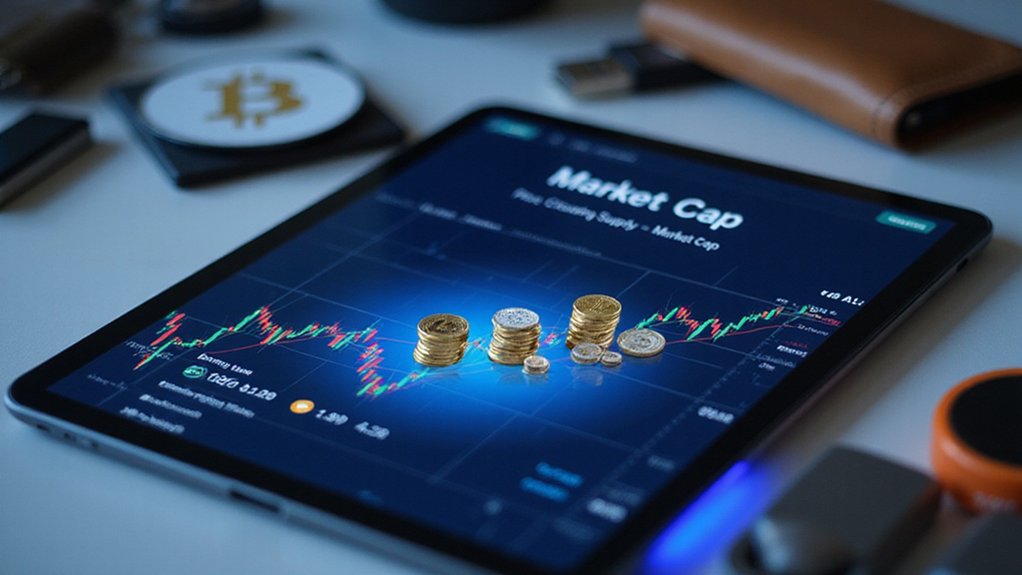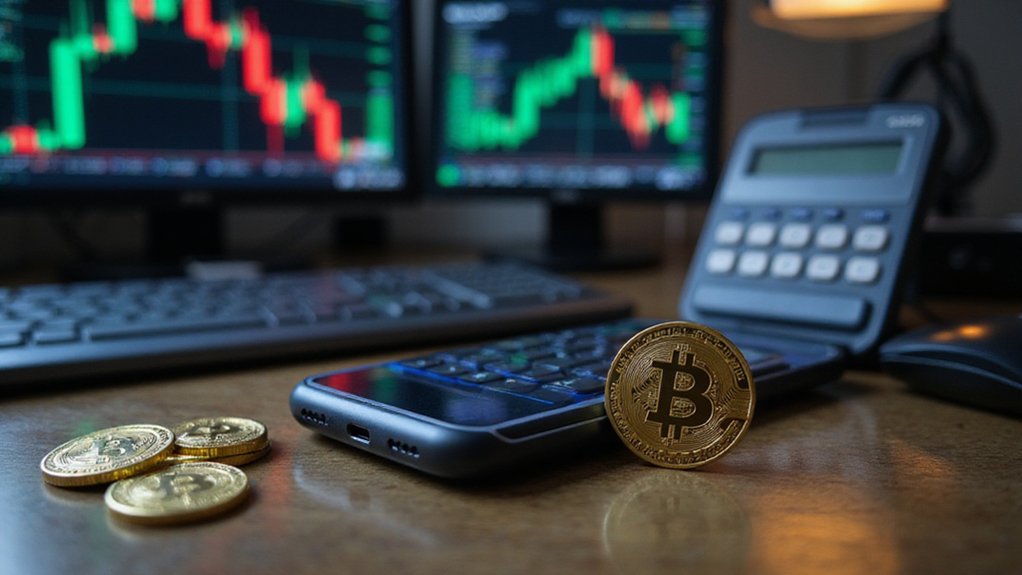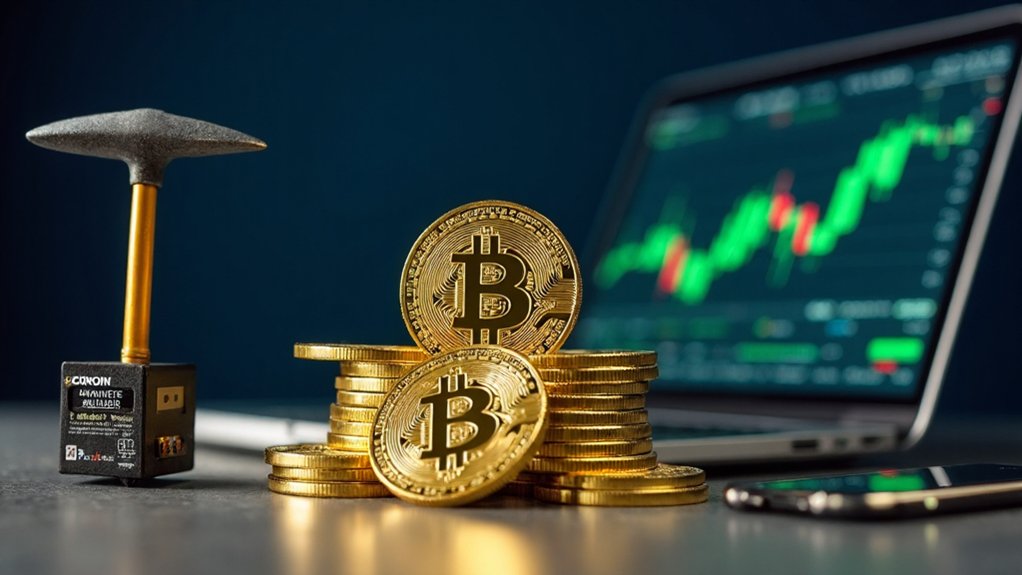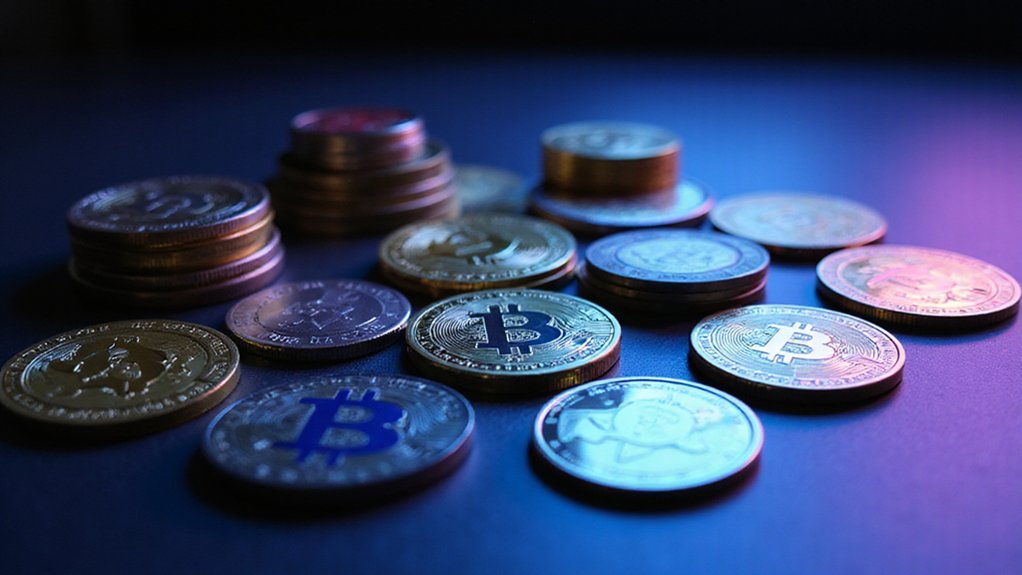Calculating crypto market cap requires nothing more than elementary arithmetic: multiply the current token price by its circulating supply. A coin trading at $100 with 1 million tokens in circulation equals a $100 million market cap—a deceptively simple equation that belies the metric’s significance. This figure helps investors categorize assets (large-cap, mid-cap, small-cap) and serves as a crude proxy for liquidity. The true utility emerges when comparing assets across the fragmented crypto ecosystem.

Why do some cryptocurrencies command billion-dollar valuations while others languish in obscurity? The answer often lies in market capitalization—a metric that investors scrutinize with near-religious devotion when traversing the cryptosphere’s turbulent waters. Market capitalization, colloquially abbreviated as “market cap,” represents the total dollar value of a cryptocurrency’s circulating supply and serves as a fundamental indicator of a digital asset’s economic footprint.
The calculation itself is strikingly straightforward: multiply the current price of a cryptocurrency by its circulating supply.
For instance, a cryptocurrency trading at $100 with 1 million tokens in circulation would boast a market cap of $100 million.
This deceptive simplicity, however, belies the complex dynamics that influence the resultant figure.
Both variables in this equation—price and supply—fluctuate continuously in response to market forces, regulatory developments, technological advancements, and occasionally, the inscrutable whims of social media influencers¹.
Understanding market cap classifications provides essential context for investment decisions.
Large-cap cryptocurrencies (think Bitcoin and Ethereum) typically offer relative stability but modest growth potential.
Mid-caps present a balanced risk-reward profile, while small and micro-caps—those speculative darlings of risk-tolerant investors—combine heart-stopping volatility with occasional, life-altering returns.
The discerning investor constructs portfolios reflecting their risk appetite by strategically allocating across these categories.
As of March 2024, Bitcoin’s impressive large-cap status of approximately $1300 billion towers over most other cryptocurrencies in the market.
This market cap calculation applies across currencies, allowing investors to analyze cryptocurrencies in various fiat denominations like USD or Euro.
Market capitalization transcends mere numerical representation; it functions as a barometer of market confidence.
Rising caps without supply increases signal growing investor conviction, while dramatic cap contractions often presage broader market corrections.
Moreover, market cap serves as a crude proxy for liquidity—larger caps generally correlate with easier entry and exit positions.
The classification threshold typically categorizes cryptocurrencies with market caps exceeding $10 billion as large-cap investments.
The savvy crypto investor recognizes that market cap, while invaluable, represents just one data point in a constellation of metrics.
When paired with trading volume, developer activity, and technological fundamentals, it forms part of a thorough analytical framework that separates informed speculation from blind gambling in the ever-evolving digital asset landscape.
¹The infamous “Elon effect” being the quintessential example.
Frequently Asked Questions
Does High Market Cap Guarantee a Safe Crypto Investment?
High market cap, while often perceived as a proxy for safety in cryptocurrency investing, offers no guarantees whatsoever.
Though these established digital assets typically enjoy broader liquidity and institutional recognition, market capitalization utterly fails to account for fundamental risks—technological vulnerabilities, regulatory uncertainty, or market manipulation remain omnipresent threats regardless of size.
Investors relying solely on this metric (surprisingly common among newcomers) overlook critical factors like team credibility, technological soundness, and real-world utility.
How Quickly Can a Cryptocurrency’s Market Cap Change?
Cryptocurrency market caps can transform with breathtaking speed—often within minutes.
Price volatility serves as the primary catalyst, with 24-hour swings routinely reaching ±5% (and occasionally far more dramatic figures for smaller tokens).
Sudden market-moving news, large transactions from institutional players, and supply adjustments through burns or releases can radically alter valuations before most investors have finished their morning coffee.
Micro-caps experience particularly violent fluctuations due to limited liquidity.
Why Do Some Low Market Cap Coins Outperform Higher Ones?
Low market cap cryptocurrencies often outperform their established counterparts due to simple mathematics—moving from $1M to $10M (a 10x increase) requires substantially less capital inflow than pushing Bitcoin from $1T to $10T.
Their heightened volatility, while doubling risk, also doubles reward potential.
Additionally, these nascent projects typically trade on innovation promises rather than proven fundamentals, attracting speculators willing to gamble on the next paradigm-shifting protocol (however statistically improbable that outcome may be).
Can Market Cap Predict Future Crypto Prices?
Market cap serves as a barometer of investor sentiment rather than a crystal ball for price predictions.
While higher capitalization generally indicates broader adoption and stability (those ever-elusive qualities in crypto markets), it remains merely one factor in a complex ecosystem.
The correlation between market cap and future performance exists, but it’s tenuous at best—akin to using tide patterns to predict tomorrow’s weather.
Informed investors consider it alongside volume, development activity, and tokenomics.
How Does Token Burn Affect a Cryptocurrency’s Market Cap?
Token burning affects market cap in a mathematically interesting interplay of supply and price dynamics.
By permanently removing tokens from circulation, burns reduce total supply—potentially increasing scarcity and per-token value if demand remains constant.
Theoretically, the equation market cap = price × circulating supply demonstrates how burns might counterintuitively maintain or increase overall valuation despite supply reduction, provided price appreciation proportionally exceeds supply contraction.
Regular scheduled burns, like BNB’s quarterly rituals, strategically manage inflationary pressures.









